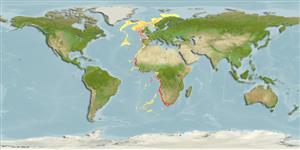Elasmobranchii (sharks and rays) >
Rajiformes (Skates and rays) >
Rajidae (Skates)
Etymology: Rajella: Latin, raja, -ae = a sting ray (Raja sp.) (Ref. 45335).
More on author: Norman.
Environment: milieu / climate zone / depth range / distribution range
Ecology
Marine; bathydemersal; depth range 102 - 1207 m (Ref. 106604). Deep-water
Eastern Atlantic: off Mauritania to South Africa, probably throughout on the deep, middle and upper slope, even on outer shelf of Namibia and South Africa.
Size / Weight / Age
Maturity: Lm ? range ? - ? cm
Max length : 75.0 cm TL male/unsexed; (Ref. 106604)
Found on the outer shelf and upper slope (Ref. 5578). Feeds on small crustaceans, squid and polychaete worms (Ref. 5578). Oviparous (Ref. 50449). Eggs have horn-like projections on the shell (Ref. 205). Taken by hake trawlers (Ref. 5578).
Life cycle and mating behavior
Maturity | Reproduction | Spawning | Eggs | Fecundity | Larvae
Oviparous, paired eggs are laid. Embryos feed solely on yolk (Ref. 50449).
McEachran, J.D. and K.A. Dunn, 1998. Phylogenetic analysis of skates, a morphologically conservative clade of elasmobranchs (Chondrichthyes: Rajidae). Copeia 1998(2):271-290. (Ref. 27314)
IUCN Red List Status (Ref. 130435)
Threat to humans
Harmless
Human uses
More information
ReferencesAquacultureAquaculture profileStrainsGeneticsElectrophoresesHeritabilityDiseasesProcessingNutrientsMass conversion
Tools
Special reports
Download XML
Internet sources
Estimates based on models
Preferred temperature (Ref.
123201): 4.6 - 11.8, mean 7.3 °C (based on 89 cells).
Phylogenetic diversity index (Ref.
82804): PD
50 = 0.5000 [Uniqueness, from 0.5 = low to 2.0 = high].
Bayesian length-weight: a=0.00324 (0.00198 - 0.00529), b=3.22 (3.08 - 3.36), in cm total length, based on LWR estimates for this species & (Sub)family-body (Ref.
93245).
Trophic level (Ref.
69278): 3.5 ±0.43 se; based on food items.
Resilience (Ref.
120179): Low, minimum population doubling time 4.5 - 14 years (Fec assumed to be <100).
Fishing Vulnerability (Ref.
59153): Moderate to high vulnerability (50 of 100).
Nutrients (Ref.
124155): Calcium = 9.41 [1.70, 47.02] mg/100g; Iron = 0.362 [0.086, 1.105] mg/100g; Protein = 16.6 [13.7, 19.2] %; Omega3 = 0.615 [0.183, 2.451] g/100g; Selenium = 15 [4, 49] μg/100g; VitaminA = 7.58 [1.88, 30.92] μg/100g; Zinc = 0.34 [0.17, 0.63] mg/100g (wet weight);
